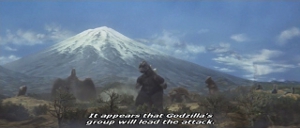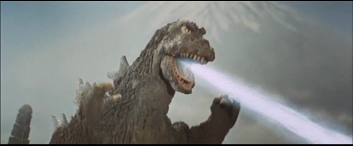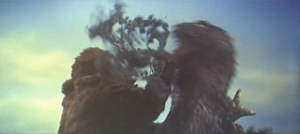
For G-fans, this is the Big One, the culmination of all that came before. It’s easy to see why since Kaijû sôshingeki (“Charge” or “Invasion” or “Attack of the Monsters“; take your pick) hits the ground running with none of the drawn-out build-up we’ve come to expect from these flicks…especially those directed by Ishiro Honda. By the eleven minute-mark, Godzilla’s nuking the UN and his monstrous colleagues are reducing other major cities to scrap. By the end of the film, ten monsters engage the twice-defeated (yet inexplicably popular) King Ghidorah in a no-holds-barred brawl in the shadow of Mt. Fuji, which became legendary before the film’s premiere.
So the number one reason cited for out-and-out loving Destroy All Monsters is totally valid. Here, you really can get more monsters for your money and the scope of that Climactic Battle is mind-bending, both as a piece of cinema and as a technical landmark in film making history. Ten monsters, most of them actors in costumes, the rest puppets, all requiring some manner of off-screen puppeteers to keep up the illusion. It was a logistical nightmare of actors and wires and animatronics, all under hot lights, sixteen hours a day…but thanks to the magic of editing and shot composition, its made not only beautiful, but enduringly awesome.
For many G-fans, that fight alone ensures this film can do no wrong. For others, Destroy All Monsters can do no wrong because it was their introduction to Godzilla and his universe. A certain generation (the one right ahead of mine, in fact) grew up seeing this film on network TV, where it played with varying degrees of regularity until the 1980s. This was back in the days when there were only three networks and they bought up catalogs of cheap, old films to shore up their schedules. Continue reading Destroy All Monsters (1968)









